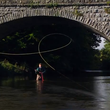If you're hip enough to find yourself in the midst of a conversation about monofilament manufacturing, you'll likely hear a quip that goes something like "it all comes from the same three factories in Japan anyhow!" In reality, this isn't the case. Monofilament manufacturers operate factories in Japan, China, India, here in the USA and lots of other places. That said, it is true that many major fly fishing brands, such as those highlighted below, work with some of the leading Japanese manufacturers of nylon, copolymer and nylon monofilament.
Gear trend: stronger leaders, tippet for 2016
by Chad Shmukler - Wednesday, Sep 2nd, 2015




























